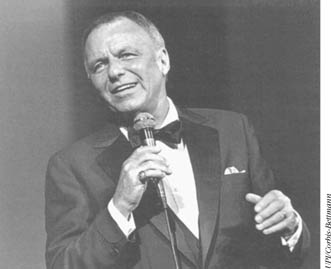
Frank Sinatra, known affectionately as “ole blue eyes, giving one of his professional, polished performances.
There is little doubt that Frank Sinatra was the greatest popular singer of his generation. Thanks to his outstanding technical ability, instantly recognisable, mellow baritone, and overwhelming charisma, Sinatra remained at the top of his profession for five decades, earning himself legendary status in the process.
Francis Albert Sinatra was born on December 12, 1915, in Hoboken, New Jersey. He began to sing in local clubs at age 18, and in 1939 became the vocalist for trumpeter Harry JAMES’S big band. By 1940 he had moved on to the Tommy DORSEY band, recording songs that are still among his best loved, such as “I’ll Never Smile Again,” and “I’ll Be Seeing You.”
While he was with Dorsey, Sinatra began to perfect a rhythmic, jazzy style that worked well with the band’s swing arrangements. Sinatra’s elastic phrasing and relaxed, yet strong approach made him stand out from other big band singers. With his gangly frame, Sinatra cut an awkward, vulnerable figure on stage, and this image helped to earn him a following of young female admirers, known as “bobby-soxers.”
In 1943 the ambitious Sinatra parted ways with the Dorsey band to go solo. He signed with Columbia Records, teaming up with arranger Axel Stordahl to produce a string of hits including “Nancy (With the Laughing Face),” and “Dream.” Sinatra also began a highly successful film career, appearing in lightweight musicals such as Higher and Higher (1944) and Anchors Aweigh (1945).
Sinatra’s fortunes started to wane towards the end of the decade, but his career was kickstarted by his highly acclaimed performance in the film From Here to Eternity (1953), for which he won an Oscar for best supporting actor. He also starred in Ocean’s Eleven (I960), and The Manchurian Candidate (1962). Sinatra moved to Capitol in 1953, where he began his long collaboration with arranger Nelson Riddle, whose unconventional, atmospheric orchestrations perfectly matched Sinatra’s style. During this time, Sinatra began to record theme albums such as In the Wee Small Hours (1955), Songs for Swingin’ Lovers (1956), and Sinatra Sings for Only the Lonely (1956). This period saw Sinatra produce his best material, though it wasn’t until 1969 that he recorded “My Way,” the song that would become his signature tune.

Frank Sinatra, known affectionately as “ole blue eyes, giving one of his professional, polished performances.
Sinatra continued to record during the 1970s and 1980s, but increasingly concentrated on live performances, particularly at his “second home” of Las Vegas. By this time, Sinatra’s voice was beginning to show signs of wear and tear, yet audiences were still won over by the singer’s showmanship and charisma. Even with much of his vaunted range gone, Sinatra never lost his ability to throw himself completely into a song.
The 1990s saw several “farewell” performances, as well as a series of collaborations with contemporary artists such as Bono of U2. Frank Sinatra died on May 15, 1998, mourned by millions throughout the world.
Jim Allen
SEE ALSO:
ARRANGERS; FILM MUSICALS; POPULAR MUSIC.
FURTHER READING
Freedland, Michael. All the Way: A Biography of Frank
Sinatra (New York: St Martin’s Press, 1998);
Hawes, Esme. The Life and Times of Frank Sinatra
(Philadelphia, PA: Chelsea House, 1997).
SUGGESTED LISTENING
In the Wee Small Hours; Sinatra Sings for
Only the Lonely, Songs for Swingin’ Lovers.